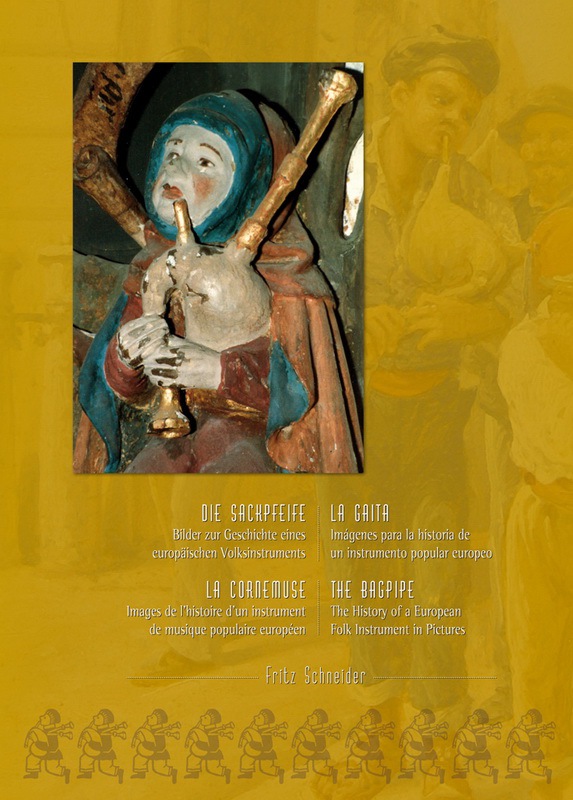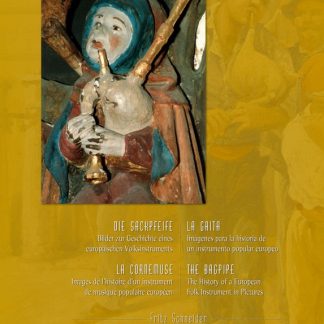Description
This fascinating coffee table book illustrates the history of the bagpipe. On 184 four-color printed pages, Dr. Fritz Schneider publishes a selection of fascinating illustrations from his extensive iconographic collection. For half a century, he has tirelessly collected all discoverable illustrations dealing with this drone instrument.
The bagpipe, also known as the bagpipes, was once common among all European peoples as well as in North Africa and the Orient. Throughout history, it has been depicted by artists and craftsmen in a variety of techniques such as drawings, paintings, sculptures and sculptures. Images can be found as religiously revered pictures as well as political caricatures, as genre representations or as decorations of everyday objects.
To research the history of a musical instrument, a scientist will first try to consult preserved original instruments. However, this method encounters difficulties with the bagpipe, more so than with most other instruments. The distinguishing part of these instruments, namely the bag, is usually made of leather or rudimentary tanned animal skin. Both fabrics are very sensitive to moisture, but this is constantly supplied to them with the player’s breath. On the other hand, the bag can also dry out if the instrument is not played for a long time. In both cases, the bag is destroyed. What remains are the pipes, which are often no longer recognized as parts of a bagpipe. This is probably the reason why historical specimens of the bagpipe are so rare to find.
Therefore, anyone researching the history of the bagpipe must rely on other sources. Written evidence is not uncommon in literature, travel descriptions, court records, and other documents – but exact descriptions of the instrument are rare in them. However, with the help of iconography, the interpretation of image content, it is possible to gain information about the historical development and distribution.
In selecting the 83 images, the author took care to include the bagpipes of as many peoples as possible. The book contains picture sources from all periods of the last thousand years.
The work is divided into six chapters:
- Design and function
- Diversity of peoples – diversity of bagpipes
- Sociology of musicians – hierarchy of instruments
- Allegory and symbol
- History and little histories
- Problems of representation – problems of interpretation
The illustrations, some of which are printed on full pages, are explained and commented on in detail in four languages (German / English / French / Galician). The author not only discusses the instrument depicted, but also provides fascinating information about its historical, technical, regional and social background.
English:
This fascinating book illustrates the history of the bagpipe. On 184 four-color pages Dr. Fritz Schneider presents a selection of fascinating images from his extensive iconographic collection. For half a century now he has collected images that deal with these drone instruments which were once played in all European nations as well as in North Africa and the Middle East.
When researching the history of a musical instrument a scientist will preferably refer to preserved original instruments. With the bagpipe this method usually meets difficulties stronger than those connected with other instruments. The characteristic part of this folk instrument, the bag, is generally made of leather, or, as is the case with so-called primitive examples, of rudimentarily tanned animal skin. Both materials are rather sensitive to the moisture resulting from blowing air into it. On the other hand the bag could dry out when the instrument is not being played for a longer period of time. In both cases the bag will decay. Without the bag, the remaining pipes may not be recognized as parts of a bagpipe. This could be the reason why so few historical examples of bagpipes are found. Another reason could be the fact that, with the exception of the baroque “Musette”, this folk instrument in the past centuries was made of cheap materials and therefore not considered a valuable object.
For the research of this interesting folk instrument one depends therefore on other sources. Written sources are not unusual in literature, itineraries, legal deeds and other papers, but precise descriptions of the instrument are rare in such texts. With the help of iconographic sources it is possible, however, to extract evidence regarding the historical development.
The bagpipe has been depicted now and again by artists and craftsmen in a great variety of media, such as drawings, paintings, sculptures and pottery. Depictions can be equally encountered in religious pictures and political caricatures, in genre-pieces or as decorations of utensils.
Such iconographic evidences are selected to offer and illustrate a survey of the history of this interesting folk instrument. 83 pictures present bagpipes from many different nations from all periods of the last thousand years.
The work is divided into six chapters:
- Construction and Function
- Diversity of Peoples – Diversity of Bagpipes
- Sociology of the Musicians – Hierarchy of the Instruments
- Symbol and Allegory
- History and Stories
- Problems of Representation – Problems of Interpretation
All illustrations are commented in four languages (German / English / French / Gallego). The author does not only refer to the depicted instrument but also gives information on history, technical, regional and social backgrounds.
Order no.: 98-8
ISBN: 978-3-927240-98-8
Format: DIN A4
Number of pages: 184 pages
Cover: Softcover with thread stitching







Reviews
There are no reviews yet.